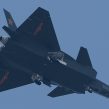
The Curious Incident of the Stealth Fighter in China
Publication: Eurasia Daily Monitor Volume: 8 Issue: 33
By:

China’s January 2011 announcement of its new J-20 stealth fighter caused consternation in the US. Indeed, the subsequent blizzard of press controversy led the Pentagon to admit that its intelligence had underestimated China’s progress and capability in building an air force. Lost in all this controversy is the fact that nobody knows for certain the precise stealth capability of the J-20 and its avionics and technological capabilities. Specultion abounds that China copied US or Russian models, while China is either silent or intimates that it did this wholly indigenously, which is a rather unlikely possiblity. By comparison, the Russian reaction was quite restrained and almost invisible. Given Russia’s proximity to China, its status as China’s largest supplier of foreign military systems, and signs thorughout 2009 and 2010 of mounting Russian concern over the growing Chinese military prowess, this silence seems strange. But in fact there is method in this “madness.”
As reported abroad, Russian analysts also do not know the precise characteristics of this aircraft. One writer, Konstantin Sivkov, the Vice-President of the Academy for Geopolitical Issues, and a former General Staff officer, argued that the US is correct in general to be alarmed at the progress of Chinese military technology. According to Sivkov, China has shown a capacity for strategic technological breakthroughs to reach the most advanced positions in the next 5-15 years. Nevertheless, Washington should not believe that the J-20 comes anywhere near the F-22 in terms of weaponry, surveillance, and target acquisition capability. However, Sivkov warned, China could surpass Russia whose defense industrial sector still relies on Soviet models (Interfax-AVN, January 17). However, Sivkov has no direct access to intelligence on the J-20 and his opinion is by no means a majority one.
Although little or nothing has been written in the Russian press, Russian analysts have evidently been quoted abroad. The Hong Kong newspaper, Ta Kung Pao Online, quoted Alexander Khramchikhin of the Moscow-based Institute for Political and Military Analysis, an analyst who has been warning of the Chinese military threat for several years, as saying that the J-20 appears to have combined US F-22 Raptor’s nose section and air intake with a tail section that includes a tail wing, vertical stabilizer and engine exhaust design reproducing the prototype for Russia’s projected fifth generation stealth fighter, the T-50. Therefore, it is possible that China might develop its fifth generation fighter before Russia does. Moreover, since fifth-generation fighters are the future of air warfare and masters of the skies in future war, the US and Russia are carefully scrutinizing the J-20 (Ta Kung Pao Online, January 20).
However, Jane’s Defense Weekly (significantly, for the most part not the Russian press) cited a division of opinions among Russian industry specialists who are equally uncertain as to what the exact capabilities of the J-20 are and the extent to which China still depends on Russia, particularly with regard to engine technology, for its air force (Jane’s Defense Weekly, January 27). Ilya Kramnik, writing for RIA Novosti argued that China intends to construct a wholly new aircraft, possibly combining US and Russian models in innovative ways to build a stealth fighter that could compete with US and Russian models, though Kramnik is not sure of this (RIA Novosti, December 29, 2010) As a result, Russian experts join a considerable degree of skepticism to concern about China’s claims about a stealth fighter (Jane’s Defense Weekly, January 27).
That skepticism however, is public. It is likely that the Russian military, government and intelligence circles are all intensely concerned with discovering the capabilities of the J-20. But the curious incidence of the official Russian media silence about this aircraft is probably tied to the government policy of not discussing or raising the China threat in public. China is the threat that dare not speak its name, in keeping with the old Russian proverb of not calling the bear out of the woods, Moscow is determined to remain silent about it unless it suits its purposes to change this approach. No doubt the intelligence agencies have already been tasked to discover the parameters of the J-20’s capability. But just as the silence of the dog in the night alerted Sherlock Holmes to the truth concerning his case, it is precisely this relative silence, as opposed to the brief but visible hysteria in the US press, that signals Russia has a new problem to face in its mounting concern over Chinese military power. Chinese airpower has steadily grown in its capability in recent years. Indeed, US sources report that China is also investing in counter-stealth technology. Yet, while US capabilities for response to the various manifestations of China’s growing prowess are well-known and relatively visible, Russia’s abilities to respond to the threat may be strictly nuclear and there is no sign, according to Sivkov, of its defense industry’s capability to keep pace with its peers.




